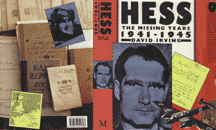| [images and
captions added by this website] 
Monday, December 27, 2004
Mrs Foley's
diary solves the mystery of Hess By Michael Smith A BRIEF entry in the diary of
the wife of a British spy has led to the discovery
of the true story behind one of the greatest
mysteries of the Second World War - the bizarre
1941 flight to Britain of Hitler's deputy Rudolf
Hess. No single incident in Britain's wartime history
has given birth to so many conspiracy theories, all
of them centred on an alleged plot by the
intelligence services to lure Hess to
Britain. Kay
Foley kept her diary between 1936 and
1942 They range from suggestions that the man
imprisoned by the Allies after the war was not the
real Hess, who allegedly died in the 1942 air crash
that killed the Duke of Kent, to claims that
British psychological warfare experts conned him
into coming to Britain so they could use him in an
anti-Nazi propaganda campaign. The response from academics has always been
disparaging. They regard the conspiracy theories as
patent nonsense and, perhaps in response,
invariably dismiss any claim of major MI6
involvement in the affair. But the diary has revealed that MI6 was not only
heavily involved in the run-up to Hess's flight but
even planned "a sting operation" aimed at luring
Hess or another prominent German into bogus peace
talks with Britain.  David
Irving comments: THERE is nothing
dramatically new in this story which
Michael Smith did not learn from reading
my 1987 book Rudolf
Hess, The Missing
Years
(Macmillan, London).
It was always
known that Haushofer had written a letter
to the Duke of Hamilton, addressed
initially to a Mrs Wilson in Lisbon (who
turned out to be an MI6 agent); the MI6
intercepted the letter and it is in
Ministry of Information (letter
censorship) archives.
MI6 told Eduard Benes of
their plot to lure Hess over. I found that
in the papers of Benes' secretary Taborsky
in Stanford University.
And we knew that
Frank Foley was Hess's chief
interlocutor at Mytchett House, southern
England,for a year after his arrival in
1941. I published his photo in the book.
Most of the transcripts of the recorded
conversations have long been released.
Isn't it amazing how an
author (Smith) can write an entire article
on the subject without mentioning by name
the book that contains all these facts,
published nearly twenty years
ago? 
|
The diary belonged to the wife of Frank
Foley, the former MI6 head of station in
Berlin, who was to become more famous for his work
in getting "tens of thousands" of Jews out of
Germany.It was Foley, as the leading German expert in
MI6, who was in charge of the year-long debriefing
of the deputy führer. This much is known from
Foreign Office files released to the National
Archives some years ago. Hess flew to Britain in a Messerschmitt-110 on
May 10, 1941, intent on making contact with the
Duke of Hamilton, who he believed would help him
mediate a peace deal whereby Britain would join
Nazi Germany in a war against the Soviet Union. It
was a hopeless mission based on a fundamental
misunderstanding of the British establishment. Winston Churchill, Britain's wartime
prime minister, was convinced that it had produced
an intelligence windfall for Britain. But Churchill was wrong. The debriefing was a
wasted effort. Hess knew astonishingly little and,
to make matters worse, Foley swiftly realised he
was mad. That is where the role of both MI6 and Foley in
the Hess affair begins and ends, according to the
files released to the National Archives. But the emergence of Kay Foley's diary, which
she had given to one of her nieces, changed all
that, sparking off an investigation that has
uncovered the truth about Rudolf Hess. Mrs Foley kept the diary for seven years, from
January 1936 to December 1942. Not unnaturally for
a journal covering such a long period, the entries
were all frustratingly brief. Foley was only ever
referred to as F (for Frank) and although records
of his official activity appeared in the diary,
they were vague. For the most part, the diary provided nothing
new about Foley and what he did. A few entries added a minor piece of new
information. One gave a precise date for a wartime
change of job, another details of when and where
Foley landed in Britain after the fall of France,
adding interesting detail of what he did before
returning home. But the most puzzling
entries by far concerned a visit to Lisbon that
Foley made in early 1941. He flew out of
Whitchurch aerodrome near Bristol on Friday, Jan
17, 1941, spending two weeks in Lisbon and
arriving back in England on Saturday Feb 1,
1941, when the diary records that Kay received a
telegram from F reassuring her that he had
arrived safely back in England. The dates were intriguing. Seven months before
Hess flew to Britain, in September 1940, one of his
close advisers, Albrecht Haushofer, the
leading expert on Great Britain in the German
Foreign Office [Website note:
wrong!] , had written to the Duke of
Hamilton at Hess's request, attempting to set up a
meeting in Lisbon. The letter, sent via an intermediary, an old
family friend of the Haushofers, was intercepted
and passed to MI5, who initially suspected Hamilton
and the intermediary might be German spies and
began an investigation. By November 1940 they had realised this was not
the case and spent some months considering whether
or not to send Hamilton, a serving RAF officer, to
Lisbon to meet Haushofer. The plan was eventually discarded as too
dangerous but the letter's very existence has
always fuelled the allegation at the heart of the
conspiracy theories -- that British intelligence
lured Hess to Britain. Conspiracy theories are easily dismissed but if
MI6 was aware that someone so close to power had
put out feelers to the British establishment, it
would be bound to consider meeting them. If the approach was from opposition forces, they
would be useful allies. If it came from someone
with Hitler's backing, it would have provided
invaluable intelligence. The dates for Foley's visit to Lisbon were
midway between the letter's interception and Hess's
arrival in Britain. They looked right. Only MI6 could say for sure what Foley was doing
in Lisbon. The service still refuses to release any
of its own files, but it does retain a number of
"old boys" as historians to look after them. Their immediate response was that Foley must
have gone to Lisbon to look at a potential
double-cross operation, a reference to the highly
successful system whereby the vast majority of Nazi
spies sent to Britain were "turned" by British
intelligence to provide false information to the
Germans. Although Foley did eventually take over as head
of the MI6 Double-Cross section, this did not
happen until 15 months later (the diary fixes the
date as April 16, 1942). Told this, the MI6 historian went back and
checked the files. What he found was the answer to
the mystery that has puzzled historians for more
than half a century. Much of the MI6 archive on Hess has been
destroyed. But in the files there was a single,
more recent reference that spoke of MI6 plans for
"a sting operation" in response to the Haushofer
letter. The MI6 historian also has access to oral
histories from former officers and, where they are
still alive, the officers themselves. By delving
into this "folk memory", he discovered that Foley
had flown to Lisbon to see whether it was possible
to use a meeting with Haushofer to set up a sting
operation. Foley was accompanied by his secretary,
Margaret Reid, who was presumably there not
just to take notes but also to provide cover -- a
middle-aged gentleman and his "niece" spending two
weeks away from the austerity of wartime
Britain. There is, frustratingly, no information on what
Foley and Reid actually did in Lisbon. But the only
effective way of checking out the viability of a
sting operation would have been to respond to the
letter and to arrange to meet either Haushofer or
another intermediary in the Portuguese capital. In an account written for Hitler after Hess flew
to Britain, Haushofer said: "I did not learn
whether the letter reached the addressee. The
possibilities of it having being lost en route from
Lisbon to England are not small after all." But he could scarcely have admitted having had
contacts with the British secret service. After
Hess flew to Britain, Haushofer was treated with a
great deal of suspicion by the Sicherheitsdienst,
the Nazi party's security service. It interrogated
him and placed his flat and office under
surveillance. At any event, whatever Foley and Reid
did in Lisbon, it took a full two weeks. They
arrived back in England with bad news. Foley had decided that the sting was too risky
and, understandably, Sir Stewart Menzies,
the chief of MI6, took the advice of his top expert
on Germany, frustrating Hess in his attempts to put
out peace feelers to the British aristocracy. As with most of the events that become the
subject of conspiracy theories, the truth about
Hess has turned out to be much more mundane.
Haushofer had always warned Hess that the attempt
to go through Hamilton was likely to fail and that
it might be necessary to send "a neutral
intermediary" to Britain. When it did fail, the deputy führer clearly
decided that he could not afford to leave such an
important task to someone else and simply came
himself.
|